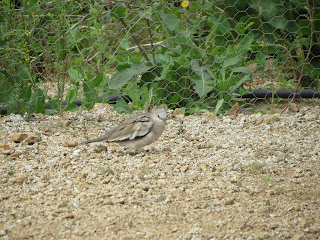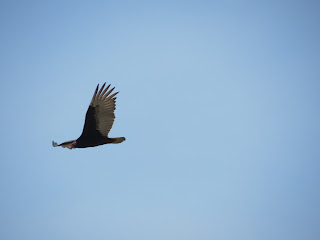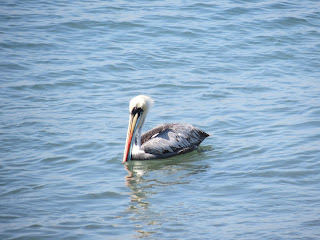The day started by travelling to La Campana National Park. On the way there we stopped at a vineyard where burrowing owls could be seen. Scanning the poles on top of the vineyard, we quickly found a burrowing owl! Also in the vineyard were several Chilean pigeons, a calling Picui ground-dove and some Californian quail.
This burrowing owl was rather cool with our presence
The Californian quail has been introduced to countries all over the world
Picui ground-doves can be told apart from eared doves by their smaller size
This large and beautiful Chilean pigeon is yet another misnamed bird in that it isn't endemic
Continuing towards the park Chilean mockingbirds became common, and several tufted tit-tyrants were seen frolicking in a nearby bush.
It was as if this Chilean mockingbird was posing for the camera!
Tufted tit-tyrants are small and fast birds, so this was the best photo I could get
We headed into the park and stopped at an area of bush good for turcas and tapaculos. We used playback and soon the calls of white-throated tapaculos hidden in the scrub could be heard. We walked behind them to get views and photos of them and then stumbled across a moustached turca.
The moustached turca is commoner than the tapaculo and much less shy
Both this white-throated tapaculo and the turca are endemic to Chile
As we continued on we saw some common diuca-finches, grey-hooded sierra finches and thorn-tailed rayaditos in an area of forest. There were also two more Californian quail here. Then we headed for our next stop, an area of beach in the seaside town Vina del Mar.As soon as we got to the beach birds were visible. Two dark-bellied cinclodes were perched on a faraway rock. A whimbrel was much more nearby and a black-crowned night heron was on the sand. Walking along the beach produced a Chilean seaside cinclodes and some ruddy turnstones. Out to sea, neotropic cormorants, inca terns, Peruvian boobies and red-legged cormorants were flying to and from little rocky islands.
Black-crowned night herons are found throughout the Americas
We got crippling views of this Chilean seaside cinclodes as it fed
We reached a large rock covered in guano and birds. At the bottom of the rock were a few South American sea lions. Covering the rock were inca terns, red-legged cormorants, Guanay cormorants, neotropic cormorants, Peruvian boobies, Peruvian pelicans and kelp gulls. Flying overhead were turkey vultures. We got good views of these birds from the University of Valparaiso building next to it.
A flock of red-legged cormorants, with a kelp gull flying overhead
Peruvian boobies, with two Peruvian pelicans and an Inca tern in front of them
A group of South American sea lions
A flying turkey vulture, these birds are common on the Chilean coast
This neotropic cormorant was very close to where we were standing
A group of Guanay cormorants with an inca tern flying over them
A swimming Peruvian pelican, this photo was taken later on at a place called Fisherman's Cove
Some Inca terns perched on a rock, you can see how the rock is covered in guano
After watching birds here we headed to Fisherman's cove, where there were close by Peruvian pelicans. We then ate some empanadas for lunch and went to a park that contained 2 platforms onto the mouth of a nearby river. Here one of my favourite birds of the trip, the black skimmer, was common, feeding in the river. A single greater yellowlegs was also wading on the shore. When we got to the second hide we noticed a large flock of birds were in front of it: black skimmers, South American terns, neotropic cormorants, white-necked herons, American oystercatchers, Franklin's gulls, kelp gulls and black-necked stilts were all present. Flying above the flock and harassing it was a single grey gull.
This lone greater yellowlegs was either an early arrival, or it stayed the winter in Chile
The white-necked heron is one of Chile's largest herons
The black skimmer feeds by dipping the longer half of its bill into water and flying
This lone grey gull managed to harass the whole flock
The flock as it flies away from the grey gull
Note the large group of South American terns at the back of the flock
A lone Franklin's gull in non-breeding plumage
This group of American oystercatchers allowed good views
After this we headed to a lagoon where the birds were too far off to photograph, but we saw snowy egrets, great egrets, cinnamon teals, cattle egrets, red shovelers, neotropic cormorants and lake ducks. Finally, we headed to a resort near an island where penguins could be seen. Upon arriving at the resort we immediately saw a fire-eyed diucon perched on a pole. Walking down to the beach and then towards the island allowed us to easily see the many humboldt penguins that made their homes there, as well as a single distant blackish oystercatcher.
The fire-eyed diucon is a species of tyrant flycatcher
Groups of these humboldt penguins were strewn all over the rocks of the island
It was a great trip and a fitting way to end our time in Chile.




























No comments:
Post a Comment